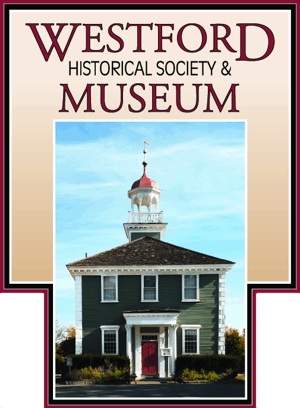Westford REV 250. In 2025 and 2026, the Westford Museum and Historical Society will commemorate the significant battles that shaped America’s struggle for independence. Discover the birthplace of American liberty, where history was made, and the future was forged. In Westford,
we proudly embrace our rich heritage, including untold and lesser-known stories that deserve recognition.
Join us in celebrating as we honor 250 years of independence.
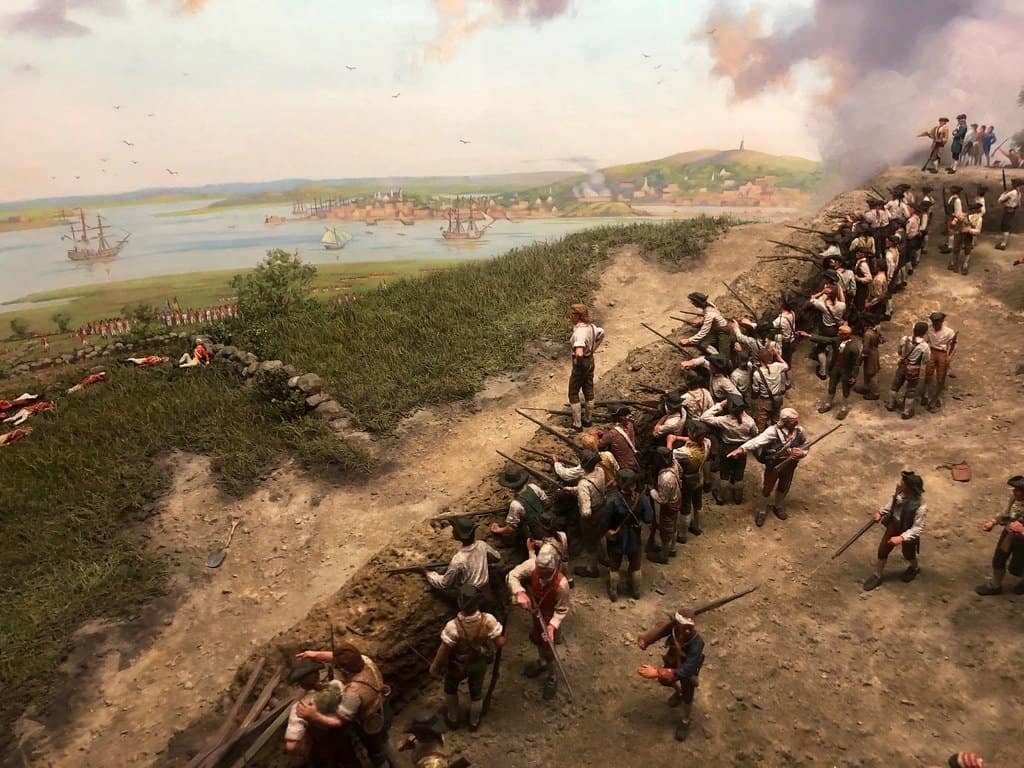
Capt. Joshua Parker
Col. William Prescott’s 10th Regiment
By Linda Greene, Director, Westford Museum
On June 17, 1775, at the Battle of Bunker Hill, one of the companies involved was led by Captain Joshua Parker of Westford with Amaziah Fassett as the first lieutenant and Thomas Rogers as the second lieutenant. Both Parker and Rogers were from Westford, while Fassett, though originally from there, was residing in Groton at the time. Tragically, Fassett was taken prisoner at Bunker Hill and died in Boston in July 1775.
Born in Westford on December 13, 1740, he was the son of Aaron Parker Jr. and Dorothy (Fletcher) Parker. He married Mary Boynton in Westford on March 15, 1764. Mary was born in Westford on December 18, 1737, and died there on November 30, 1771. She was the daughter of Nathaniel and Elizabeth (Shedd) Boynton. After Mary’s death, he married Hannah Kidder from Cambridge on March 8, 1774, in Westford.
According to Westford Vital Records, he had four children with his first wife: Joshua (1764), Patti (1767), Mary (1769), and Jeremiah (1771). He later had two more children with his second wife: Amaziah Fassett (1775) and Hannah (1778). Hodgman (p. 165) notes that he first moved to Cavendish, Vermont, in 1782 before going to New York State.
At the age of 34, he signed the Solemn League and Covenant in 1774. In that same year, the South Tax List recorded a poll tax of 6 shillings and 6 pence, with his total tax, including real and personal property, amounting to 10 shillings and 2 pence, giving him a ranking of 11.
He served as a Sergeant in Captain Timothy Underwood’s Company of Colonel William Prescott’s Regiment, responding to the alarm on April 19, 1775, for eight days. He later became a Captain, as noted in an officer return dated May 15, 1775. He also served as 1st Lieutenant in Captain Oliver Bates’s Company (10th Regiment) and served a total of 97 days as Captain after taking command from Bates on May 24, 1775.
Parker’s records indicate he served in Colonel Prescott’s Regiment with notable documents dated September 17, 1775, and January 26, 1776. He later joined Colonel Jonathan Reed’s Regiment in General Brickett’s Brigade, with ammunition returns from September 3 and November 2, 1776. He and other officers from Colonel Brooks’s Regiment were acquitted of disobeying orders and have pay records for rations from July to November 1776.
Records also document travel reimbursements for 212 miles home from Saratoga sworn on January 18, 1777. On March 14, 1778, he was included in a list of officers for two New England defense regiments. A payroll record dated October 30, 1778, shows Parker’s wages in Colonel Wade’s Regiment, where he was discharged on October 10, 1778, after completing 9 months and 10 days of service.
Sources:
Hodgman: History of Westford Pgs.: 110-113
Prescott: Patriots and Taxpayers of the Colonial Westford, MA 1774 Pgs. a-63
Colonel John Robinson, Northern Middlesex Regiment of Minutemen
commanded by Col. William Prescott of Pepperell
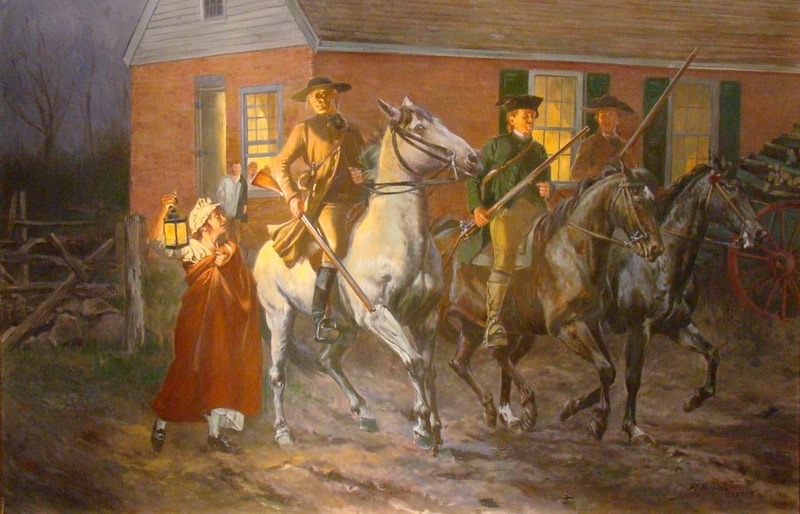
During the Battle of Bunker Hill, as well as in the struggle at Concord Bridge, Colonel Robinson took a leadership role. At that time, he was a lieutenant colonel in William Prescott’s Regiment, which held the redoubt. A tall man with a commanding presence, he stood at the front, “in shape and gesture proudly eminent,” fully aware of the danger yet committed to his duty. He would leap onto the parapet, becoming a target for the advancing enemy. He would also scout the position of the foe alongside the ill-fated Maj. Andrew McClary to determine the best strategies for repelling their persistent attacks. Throughout the engagement, he proved to be both an efficient officer and a courageous individual.
Don Troiani’s “Departure of the Minutemen” Left to right in the painting:
Hannah Parker, Joshua Parker, the Reverend Thaxter, Col. John Robinson.
By Leslie Howard, President, Westford Historical Society
Westford’s most famous Patriot, John Robinson, was born in Topsfield, MA, and settled with his wife, Huldah Perley, in Westford. Robinson served as a selectman and in the militia.
Westford’s Minuteman company fell under the command of Col. William Prescott of Pepperell. The Minutemen were a special militia group that trained more often than the regular militia, sometimes twice a week. They were expected to be ready for battle in half an hour. John Robinson served as Prescott’s Lieutenant Colonel. Given his rank in Prescott’s regiment, Robinson would have probably been on the list of officers to receive notice that the British Regulars were marching to Concord. This was around 3 AM on April 19, 1775.
Upon hearing the alarm, Westford’s Minutemen gathered on the Town Common, their training grounds. Following a brief prayer from the new Reverend Joseph Thaxter, the men, including Thaxter, set on their way to Concord, making the 10-mile journey. There, they found five hundred militia and minutemen gathering on Major Buttrick’s land. According to historians, Major Buttrick, outranked by Robinson, requested that Colonel Robinson take command, but Robinson declined as most of his militia had not yet arrived in Concord.
The men were ordered not to fire unless fired upon. Seeing the British advance, they began to pull up the planks of the North Bridge to slow them down. Then, they heard a shot. By some accounts, Colonel Robinson, upon seeing Captain Davis wounded next to him, yelled, “Fire! In the name of God, Fire!” Other accounts have Major Buttrick calling the military order. Perhaps both men yelled upon seeing their fallen comrade. The remainder of the Westford militia arrived as the battle was underway and took part in forcing the retreat of British Regulars.
Westford men served throughout the War, including the Battle of Bunker Hill, the Siege of Boston, the Battle of Valcour Island, White Plains, Trenton, Saratoga, Cherry Valley, Valley Forge, Rhode Island, and finally, the Siege of Yorktown.
Robinson’s daughter vividly remembered the night the Minutemen got the call. She recalled several men stopping by the house and that her father requested that his wife, daughters, and the hired servant cook all the provisions they could and send them via horseback to Concord. These provisions included a bushel of dough knots for lunch. Many years later, in 1975, Virginia Kimball of Westford retold the story about Col. John Robinson’s family and the dough knots in a play titled “A Day for Doughnuts.”
Despite playing a significant role in starting the American Revolution, Colonel Robinson was quiet about his time in the military. After the war, he kept a small tin cup that he used during his service, and we have it in our Museum collection.
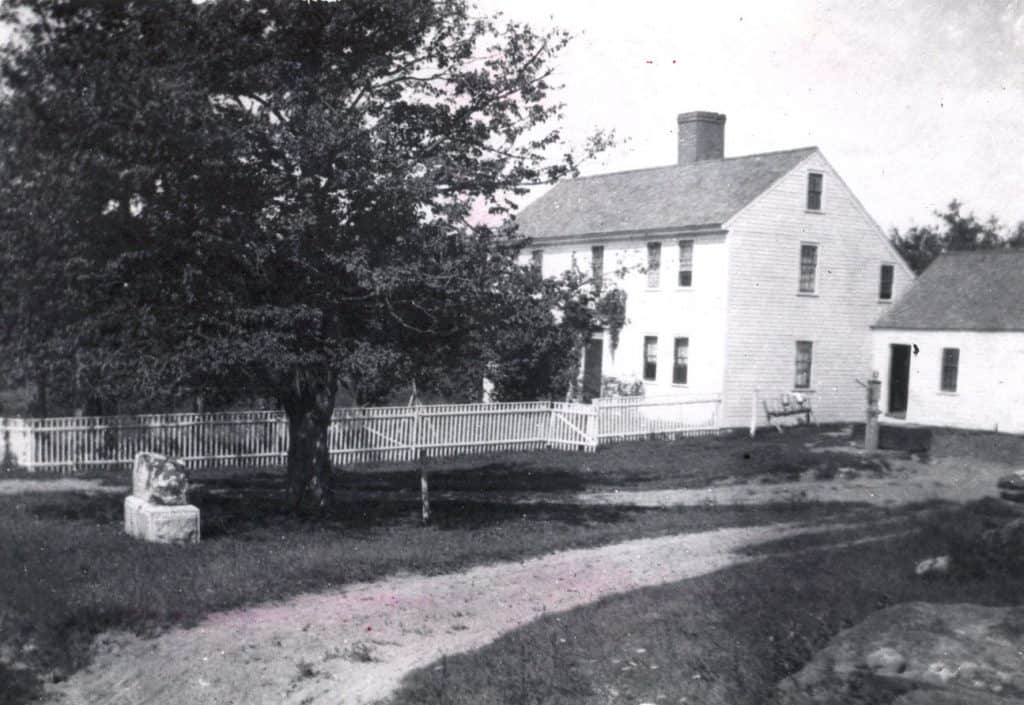
Col. John Robinson (1735-1805) and his family lived in the house once located at 17 Robinson Rd. On July 11, 1937, a fire in the barn destroyed the barn and the Robinson House. Westford’s Col. John Robinson Chapter of the Daughters of the American Revolution placed a stone monument on the road in front of the present house. The quartz boulder, supposed to be the horse block from his daughter’s home, is inscribed:
HERE LIVED
COL. JOHN ROBINSON
A BRAVE AND DISTINGUISHED OFFICER
IN THE
BATTLES OF CONCORD AND BUNKER HILL
BORN 1735 DIED 1805
Left: The Col. Robinson’s house on Robinson Rd.
As it appeared in 1902.
Westford Museum’s Video Collection relating to Col. John Robinson
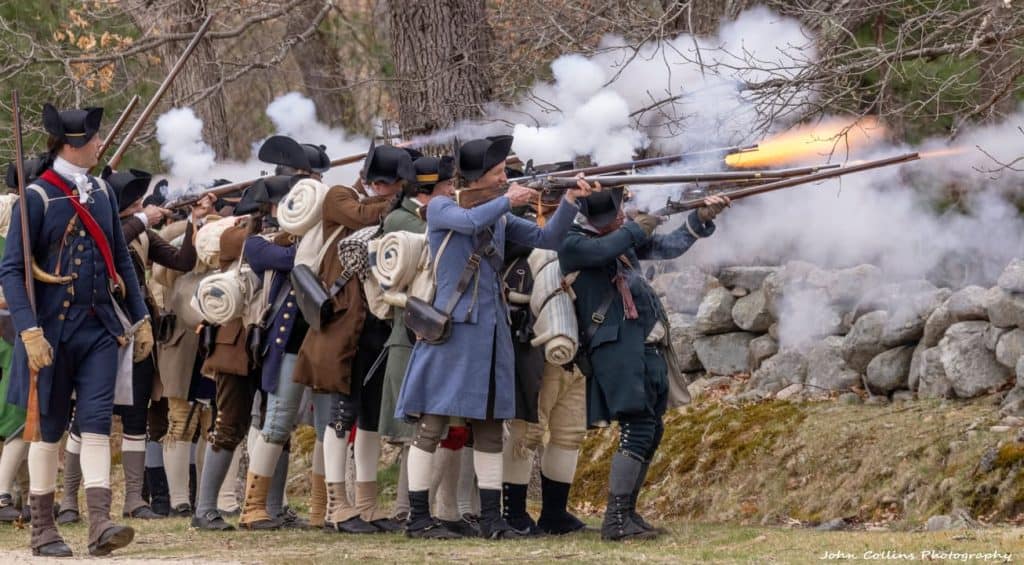
Captain Oliver Bates,
Westford’s First Foot Company
By Linda Greene, Director, Westford Museum
Oliver Bates was born to Edward and Mary Snow Bates on January 13, 1721, in Chelmsford, Massachusetts. He married Ruth Wright on January 16, 1741, at the young age of 20.
Between 1764 and 1770, Oliver Bates played an active role in his community, serving on various committees and working as a stonemason. His commitment to the cause of independence became evident in 1774 when he signed the Solemn League and Covenant and was on the North Tax List that year.
The year 1775 marked a pivotal moment in Bates’ life as he assumed the role of Captain of the First Foot Minute Company. In January, he was tasked with procuring firearms for Westford’s selectmen, successfully delivering eight guns to the town by early February. On February 27, Bates was appointed to a committee responsible for ensuring compliance with American Congress associations, demonstrating his dedication to the Patriot cause. He responded heroically to the call to defend Lexington against British troops on April 19, and by May 25, he received authorization to recruit and command new troops in Westford.
History reveals that Bates’ bravery was evident during the Battle of Bunker Hill in July 1775, where he sustained fatal wounds and died on July 4 at the age of 54. However, as we know, history is a science that is always evolving, and in the case of the death of Oliver Bartes, additional research suggests that the established facts may not be entirely accurate. Dan Lacroix, the webmaster of the Westford Colonial Minuteman webpage, offers this additional insight:
“The story of Oliver Bates has been something that has puzzled me for over 25 years.”
The contemporary accounts, like the letter from Peter Brown
(https://www.westford.org/westford1775/Peter_Brown.html), stated that he went home sick from camp in Cambridge in May. Decades later, in the pension accounts, we hear that he was wounded on April 19 and died of those wounds later. It’s consistently stated that Joshua Parker took over command of the company in May. If he were an actual casualty of the events of April 19, I would think there would have been more said about that at the time, and he is not listed on any of the casualty lists from the day. But I’ve never seen any contemporary records about him being at Bunker Hill.
In his letter to his mother about his experience at Bunker Hill shortly after the battle, Peter Brown provides the most contemporary account:
“…I did it directly (and listed) under Captn Oliver Bates, in Collo Prescott’s Regiment with whom I tarried a while till he our Captain was taken sick and went home, when Mr. Joshua Parker by succession took his place…”
In the letter, he makes no mention of Bates at Bunker Hill.
And then we have some of the later accounts, which claim that he was injured on April 19.
Jonas Holden Pension Application: 29 June 1833:
“…he was first in Capt. Bates company, & that Capt. Bates was wounded at the battle of Concord, & being confined with his wound, Capt. Parker took the command of his company, & commanded it at the battle of Bunker Hill, where the deponent was wounded by a musket shot through the thigh & was carried off the ground, & did not recover of his wound so as to do duty again until August, and in the mean time Capt Bates died of his wound – the deponent believes he either died or was buried the 4 July 1775…”
Jonas Holden Pension Application: 21 February 1835:
“I entered the service of my Country as a private soldier on the 19th of April 1775, under Capt. Oliver Bates of the Massachusetts Militia was in the engagement against the enemy that day at Concord when Capt. Bates was wounded and died in consequence of his wound, the summer following.”
John Pushee Pension Application: 1832:
“That he was a minute man in the Town of Westford in AD 1774 and on the 19th of April 1775 marched with his company to the Bridge in Concord and pursued after the enemy, in this pursuit Capt. Bates was wounded and returned home, the company proceeded”
Hodgman, p.110:
“One of our citizens, Mr. J. Boynton Reed, now living (1881), says that his father, Abijah Reed, went with Colonel Robinson’s man to Concord, but the troops had moved on, and they followed them to Lexington. Mr. Reed also says that Capt. Oliver Bates received a wound on that day from the effect of which he died July 4, 1775.”
It wasn’t until very recently that Judy Cataldo, a member of the Westford Minutemen, found a most definitive account of what appears to have happened:
“petition of Ruth Bates setting forth, that her late Husband Oliver Bates of Westford was Captain of a Company of Militia, & march’d on the Alarm the 19th of April 1775. to Cambridge, where he remained with his Men and received Orders to inlist a Company under Col’o W’m Prescot, which he accomplish’d; but in consequence of his Fatigues, & Hardships, he contracted a nervous Disorder; which render’d him incapable of supporting his Rank in the Army; in consequence there of he was bro’t to his home in Westford on the 24th of May following, and died in 6 Weeks afterwards and praying, for some allowance for nursing him &c. as he sacrific’d his Life in the cause of his Country. &c. [She was granted £4.10.10 on 17 Oct 1776.]” (https://archive.org/details/actsresolvespubl19mass/page/600/mode/2up)
Based on additional research into the death of Capt. Bates, Lacroix believes “that this contemporary account is consistent with Peter Brown’s account of Bates succumbing to an illness. Rather than a physical one, it appears to have been a mental one. Whether it was a long-standing issue or something that resulted from his experiences on April 19, we’ll probably never really know. But it is clear from the elected positions he held in town (selectman, militia captain) that he was a well-respected man who would never have reached those positions without being considered a capable and responsible member of the community. His epitaph says it all: “A Friend sincere & faithful, A Citizen virtuous & useful, A Soldier brave & valiant.”
Bates’s legacy stands as a powerful testament to the American Revolution, securing his status as a true hero. He showcased incredible bravery and strategic insight, even when faced with daunting challenges. Bates’s efforts embodied the spirit of resilience and patriotism that defined the era, motivating those around him to stand firm in the struggle for independence. His dedication and sacrifices have earned him a respected place in Westford’s history of the Revolutionary War
Sources:
Hodgman: History of Westford Pgs.: (Bates) 5, 11, 42, 43, 77, 85, 98, 103, 107, 108, 110, 160, 171, 308, 343,
Prescott: Patriots and Taxpayers of the Colonial Westford, MA 1774 Pgs.: 7, 24, 33, A-1, A-12
Dan Lacroix: Westford Colonial Minutemen webpage

Captain Jonathan Minot
Westford’s Second Foot Company
By Linda Greene, Director, Westford Museum
Jonathan Minot was born on January 19, 1723, in Chelmsford, Massachusetts, to Lt. Jonathan Minot and Elizabeth Minot Stratton. He married Esther Proctor on March 6, 1746, at 23.
Throughout his career, Minot was deeply involved in both religious and governmental matters. In 1779, he played a crucial role on an intermediary council between the Church and the town selectmen, known as the Church Committee. This committee maintained regular communication with Rev. Matthew Scribner, a prominent preacher in Westford. On November 1, 1779, the Church Committee, under Minot’s guidance, collaborated with Scribner to craft an official Confession of Faith and covenant that combined Protestant theology with state loyalty. In 1780, he was selected for a pivotal committee to shape a new governance structure in line with the Declaration of Rights.
Jonathan Minot passed away on February 7, 1806, at the age of 83, leaving behind a legacy that is firmly entrenched in history. He is celebrated for his exemplary service as Captain of the Second Foot Company and his decisive actions at Lexington in April 1775. His courageous response to that critical moment showcased his unwavering commitment to independence and solidified his enduring legacy. Beyond his military accomplishments, Minot made significant strides in local politics, playing a vital role in establishing a new governance framework for the United States. His efforts laid a strong foundation that has echoed throughout the nation, influencing the evolution of democratic governance and leaving an indelible mark on American history.
Sources:
Hodgman: History of Westford Pgs.: (Minot) 9,34, 38, 42, 91, 96, 97, 108, 110, 112, 116, 140, 147, 162, 168, 242, 268, 272, 273, 274, 286, 287
Prescott: Patriots and Taxpayers of the Colonial Westford, MA 1774 Pgs.: 9, 16, 23, A-6, A-65
Timothy Underwood was born on April 11, 1724, in Westford, Massachusetts, to Joseph and Susannah Parker Underwood. In 1746, at the age of 22, he married Rachel Russell, setting the stage for a remarkable life.
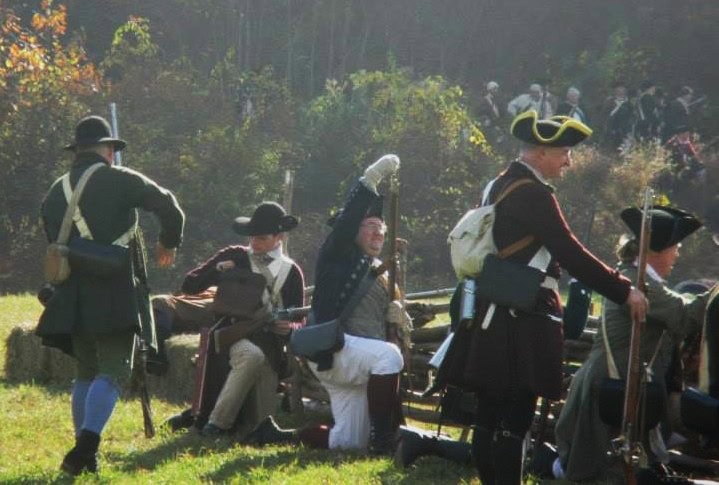
Capt. Timothy Underwood,
Westford’s Minute Company
By Linda Greene, Director, Westford Museum
In December 1748, Timothy’s father, Joseph, made a significant move by selling a piece of land, now known as the town common in Westford, for 20 pounds. Timothy first made his mark in Westford Records in 1763, taking the initiative to cover the expenses for timber to build the town’s belfry. By 1774, he had established himself in the community, signing the Solemn League and Covenant and being recorded in the North Tax List.
On April 19, 1775, Timothy emerged as a decisive leader when he responded to an urgent call to defend Lexington from British troops as the Captain of Westford’s Minute Company. His commitment to military service was recognized on May 25, when he received a commission.
Later that year, on December 16, Timothy Underwood firmly swore an oath validating the truth of his muster before Moses Gill, a provincial Justice of the Peace in Massachusetts, further solidifying his role in the American Revolution.
After his service, Timothy relocated to Putney, Vermont, where he lived until his passing on March 27, 1804, at the impressive age of 79. His legacy is a testament to his strength and dedication.
Timothy Underwood is recognized as one of the three original Minuteman captains in the rich revolutionary history of Westford, Massachusetts. Born into a family that played a significant role in the early development of the town, Underwood’s local ties and community influence may have contributed to his selection as captain of the Minute Company. This militia group was vital during the American Revolutionary War, tasked with rapid response to British military actions. Although specific evidence confirming the exact reasons for his appointment is lacking, Underwood’s leadership and commitment to the revolutionary cause underscores his importance in Westford’s historical narrative. His legacy continues to be a point of pride for the community, reflecting both his personal contributions and the larger struggle for independence.
